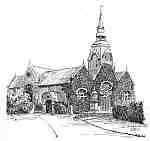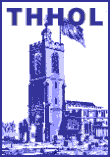 St.
Matthias' Church stands in what is now known as the Poplar Recreation Ground, midway between
High Street and East India Dock Road. It is the oldest church in Poplar, having been erected
by the East India Company as the Poplar Chapel in 1766. This Company also had a chapel in the
vicinity a century earlier. Before this time Poplar was a hamlet of Stepney, and the inhabitants
were expected to attend Stepney Church (St. Dunstan's) for their religious worship; but, like
the people of Bow, who had been in a similar position a hundred years before, they did not feel
inclined to travel over roads that were never very good and in the winter nothing more than
quagmires. There certainly had been, up to about the fifteenth century, a chapel of some sort
on the Isle of Dogs, but this was probably a private one. In an ancient record of "Stebonhethe"
it is said "that on Stebonhethe Marsh, as the Isle of Dogs was then known, there stood only
one house, the chapel of St. Mary, and it is believed to have been a small place erected by
a recluse for his own use." It is not known whether in later years it was opened for the public,
but there certainly was no provision whatever for religious worship at Poplar before 1642. In
that year the inhabitants of' Poplar and Blackwall renewed a request they had made to the East
India Company for a piece of land on which to build a chapel and also a house for the minister.
The record further states that it was resolved by the court "that the ground behind the alms-houses
already builded be granted for the purpose . . . and that sixty loads of stones be given for
laying the foundation." The Company subsequently also made a grant of £20 a year and a
field adjoining for garden. The chapel was not built, however, until1653-4. The cost was covered
by a public subscription raised by the residents, "and great satisfaction was expressed that
the people might now be able to perform their religious duties nigh to their own doors." The
chapel, being small, was soon found to be inadequate for its congregation. In 1776 the East
India Company, as a result of another petition, resolved to help again, this time much more
effectively, inasmuch as they practically rebuilt, and considerably enlarged, the chapel.
St.
Matthias' Church stands in what is now known as the Poplar Recreation Ground, midway between
High Street and East India Dock Road. It is the oldest church in Poplar, having been erected
by the East India Company as the Poplar Chapel in 1766. This Company also had a chapel in the
vicinity a century earlier. Before this time Poplar was a hamlet of Stepney, and the inhabitants
were expected to attend Stepney Church (St. Dunstan's) for their religious worship; but, like
the people of Bow, who had been in a similar position a hundred years before, they did not feel
inclined to travel over roads that were never very good and in the winter nothing more than
quagmires. There certainly had been, up to about the fifteenth century, a chapel of some sort
on the Isle of Dogs, but this was probably a private one. In an ancient record of "Stebonhethe"
it is said "that on Stebonhethe Marsh, as the Isle of Dogs was then known, there stood only
one house, the chapel of St. Mary, and it is believed to have been a small place erected by
a recluse for his own use." It is not known whether in later years it was opened for the public,
but there certainly was no provision whatever for religious worship at Poplar before 1642. In
that year the inhabitants of' Poplar and Blackwall renewed a request they had made to the East
India Company for a piece of land on which to build a chapel and also a house for the minister.
The record further states that it was resolved by the court "that the ground behind the alms-houses
already builded be granted for the purpose . . . and that sixty loads of stones be given for
laying the foundation." The Company subsequently also made a grant of £20 a year and a
field adjoining for garden. The chapel was not built, however, until1653-4. The cost was covered
by a public subscription raised by the residents, "and great satisfaction was expressed that
the people might now be able to perform their religious duties nigh to their own doors." The
chapel, being small, was soon found to be inadequate for its congregation. In 1776 the East
India Company, as a result of another petition, resolved to help again, this time much more
effectively, inasmuch as they practically rebuilt, and considerably enlarged, the chapel.
A salary of £100 was given to the minister together with pew rents, burial fees, etc. The almshouses were close to the church and facing High Street. They were occupied by twenty-two aged pensioners of the Company and were in existence until about fifty years ago when the houses and the field which lay behind them were acquired by the Poplar Board of Works and made into a Recreation Ground. During recent times the chapel has under gone further changes, having been almost rebuilt, and since 1866 the church of St. Matthias has had a regularly assigned ecclesiastical district. In the church and burial ground lie some of the most honoured and popular former residents of Poplar. There is a tablet to the memory of George Green in the church, but he is not buried here, as is the erroneous belief of many, but lies in the grounds of Trinity Chapel close by. On the south wall is a monument to Robert Ainsworth, the compiler of a famous Latin dictionary used by many generations of schoolboys. Ainsworth was born in Lancashire, and kept a school for many years in the eastern suburbs of London. He died in 1743, at the age of eighty-three, and a Latin epitaph written by himself is inscribed on his monument. On the north wall is a bas-relief by Flaxman, with an epitaph by Hayley, to the memory of George Steevens, the Shakespearian commentator.
The eight pillars in the church, seven of which are of wood, have led to great controversy as, according to tradition, they were made from the masts of vessels in the great Spanish Armada. This has been proved to be untrue, as a document in the British Museum dated 1575 states that the masts and yards of the ships were to be of the best Prussian pine from Flanders. Upon examination by experts from the Kew Botanical Gardens, of samples bored from the columns, they were discovered to be made of oak; further, the ships of that great fleet were much too small to carry masts of such weight and size.
It is an attractive church with an interesting history, and the interior is both beautiful and simple. The wooden eagle of the lectern is excellently carved, and is said to be the work of a ship's carpenter. The ceiling of the nave is decorated by a finely carved coat of arms of the East India Company. There is also a very beautiful window, dedicated in 1920 to the East London Freemasons who fell in the Great War.
by T. H.
